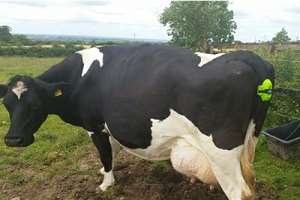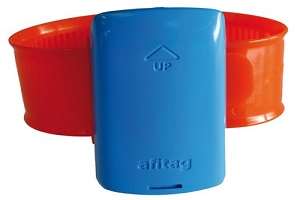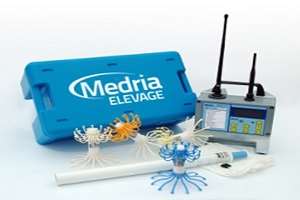Technology takes monitoring cows at calving time to a new level.
Knowing when a cow is going to calve can improve calf survivability as assistance can be provided during difficult calvings and colostrum can be fed promptly after birth. Dystocia is defined as delayed or difficult parturition and is a major cause of weakness, morbidity, and mortality in calves and increases the incidence of postpartum disorders in cows. A prolonged and difficult calving may cause acidosis and hypoxia in the calf, which can negatively affect immunoglobulin G absorption and influence calf health and future production. Providing calves with high quality colostrum immediately after calving will increase calf survival by protecting the calf against diseases. Inadequate colostrum consumption shortly after birth can result in reduced growth rates, increased risk of disease and death, increased risk of being culled, and decreased milk production in their first lactation.
Observation during calving can be beneficial to both the dam and the calf; however, it is difficult to predict time of calving on the basis of visual signs alone. Using technology to identify cows in active labor can help minimize prolonged calving and improve the overall health and profitability of your operation. Researchers have found that almost 50% of all calf deaths within the first 24 hours after birth are a result of calving difficulty. While monitoring heifers and cows due to calve is vital in improving calf survival, it can be difficult to carry out as calvings can occur at any time of the day and night.
Calving sensors and temperature sensitive devices are available on the market that will send a text message to your cell phone, alerting you that a cow is calving. This technology can provide peace of mind as you will be warned of imminent calvings, allowing you to sleep peacefully. Here are brief descriptions of 4 calving alert systems. This list may not include all available products. No discrimination is intended and no endorsement by Penn State Extension or by the author is implied.
- The Moocall is a non-invasive, tail-mounted sensor that measures tail movement patterns triggered by labor contractions. The device is placed on the tail of the cow opposite her vulva. When the cow reaches a certain level of intensity and tail movement, the Moocall sends a text alert to your cell phone; on average the alert happens 1 hour prior to calving. If calving has not occurred after 4 days, the device should be taken off for around 4 hours before placing it back on the tail. Moocall devices can be washed gently with a brush under running water after every calving and can last up to 5 years when properly maintained.

- The AfiAct II Leg Tag is an automatic heat detection system that shows direct correlation between the timing of estrus and the cow’s increased walking activity. The sensor measures the walking, resting, and standing activity of cows and heifers. The AfiAct II now has incorporated a calving alert system that sends an alert wirelessly from a leg-mounted sensor to your cell phone within 4 hours from the onset of calving. The device will send another alert if calving is prolonged. It can integrate with AfiMilk’s farm and milking parlor system and also available as a standalone system.

- The Cow Call is a compact light- and temperature-sensitive device that is inserted intravaginally up to 14 days prior to calving to measure spikes in body temperature. The device activates when the cow’s water breaks and it is pushed out; it will then detect light and send a message to your cell phone. The device can sync with up to 5 phones, and the inserts can be washed, sterilized, and reused for up to 2 years.

- The Vel’Phone is a thermometer that is placed in the vaginal canal just behind the cervix approximately 7 to 10 days before expecting calving and informs you via text message of the day-to-day changes in temperature, the proximity of calving, and when a cow is in active labor. When the cow is within 36 to 48 hours of calving, her internal temperature will begin to significantly drop and a text message will be sent to your cell phone. Another text message will be sent when the thermometer is expelled when the water breaks to inform you of when the cow is in active labor. This device requires a radio base for collecting the thermometers' data.
Calving sensors and temperature-sensitive devices can significantly improve calf survival, cow and calf health, and the profitability of your operation. These devices are an effective management tool that work well in combination with human observation of periparturient cattle.
Source: psu.edu